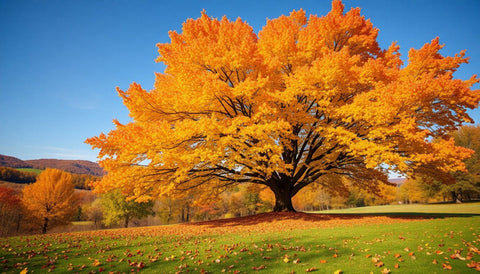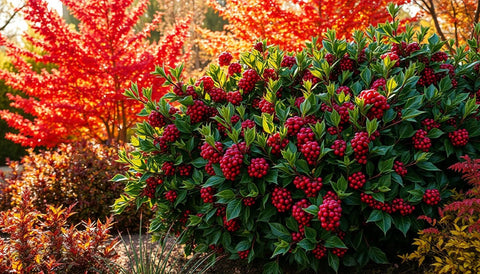Introduction
Trees play a crucial role in landscaping, offering beauty, shade, and environmental benefits. As the seasons change, fall foliage brings a burst of vibrant colors, enhancing any outdoor space. In this blog, we’ll explore trees that provide ample shade during the summer and breathtaking color displays in the fall.

Section 1: The Benefits of Fall-Foliage Trees
1.1 Aesthetic Appeal
Fall foliage trees bring vibrant hues of red, orange, and yellow to the landscape, transforming your outdoor space into a picturesque setting during autumn.
1.2 Environmental Impact
In addition to their beauty, trees improve air quality, offer shade that reduces energy consumption, and support local wildlife by providing food and shelter.
1.3 Home Value
A well-landscaped yard featuring attractive trees can significantly increase property value, making your home more appealing to potential buyers.
Section 2: Key Characteristics to Consider
2.1 Size and Growth Rate
It’s important to select trees that fit your space. Consider the mature height and width of the tree to ensure it has enough room to grow without interfering with nearby structures.

2.2 Climate Adaptability
Choose trees suited to your hardiness zone to ensure they thrive in your local climate conditions.
2.3 Maintenance Level
Some trees require more care than others. It’s important to know the tree’s watering, pruning, and overall maintenance needs to match your available time and effort.
Section 3: Top Trees for Fall Shade and Color
3.1 Sugar Maple (Acer saccharum)
The Sugar Maple is known for its dense canopy that provides excellent shade in summer and its vibrant yellow, orange, and red hues in fall. It thrives in well-drained soils and is ideal for cooler climates.

3.2 Red Maple (Acer rubrum)
With its striking red fall foliage, the Red Maple is a popular choice for both shade and seasonal color. It adapts to various soil types and climates, making it a versatile tree for many landscapes.
3.3 Sweetgum (Liquidambar styraciflua)
The Sweetgum tree features star-shaped leaves that turn rich shades of red, purple, and orange in the fall. It offers great shade in the summer and thrives in both moist and well-drained soils.
3.4 Oak Trees (Quercus spp.)
Various species of oak provide sturdy shade trees with stunning autumn colors ranging from gold to deep red. Oaks are long-lived and provide shelter for wildlife while offering beautiful fall displays.
3.5 Sassafras (Sassafras albidum)
The Sassafras tree is unique for its varied leaf shapes and striking multi-colored foliage, which includes shades of orange, yellow, and red in the fall.

3.6 Black Tupelo (Nyssa sylvatica)
Known for its glossy green leaves that turn a fiery red in autumn, the Black Tupelo is a striking shade tree with great ecological benefits, supporting wildlife and enhancing biodiversity.
3.7 Paper Birch (Betula papyrifera)
The Paper Birch adds stunning bright yellow leaves in fall and provides a beautiful contrast with its white bark, making it a striking addition to any landscape.
Section 4: Planting and Caring for Your Fall Foliage Trees
4.1 Optimal Planting Times
Fall and early spring are the best times to plant these trees. Planting during these seasons allows the roots to establish before extreme weather sets in.
4.2 Soil and Watering Needs
Each tree has specific soil preferences, but most of the trees listed thrive in well-draining, loamy soils. Regular watering during the first few years is essential for establishing strong roots.
4.3 Pruning and Maintenance Tips
Prune your trees in late winter to remove dead branches and encourage healthy new growth. Regularly check for signs of pests or disease and address any issues promptly.

Section 5: Conclusion
Incorporating fall foliage trees into your landscape brings year-round benefits—from shade in the summer to vibrant colors in autumn. Whether you’re looking to enhance your home’s value or simply enjoy nature’s seasonal display, there’s a tree on this list for every space and style.
We’d love to hear from you! Share your favorite fall trees or landscaping tips in the comments below.





























Comments (0)
There are no comments for this article. Be the first one to leave a message!